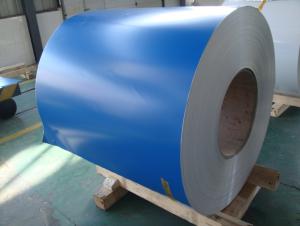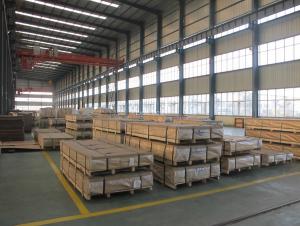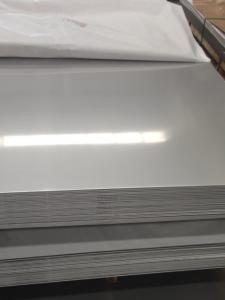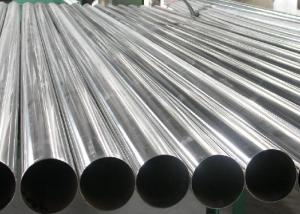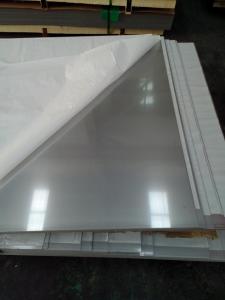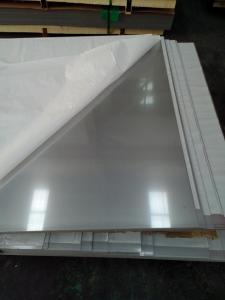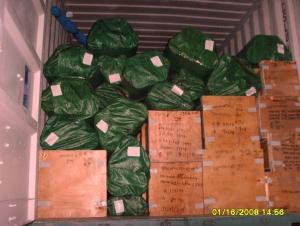Stainless Steel Cold Rolled Sheet Stocks In Warehouse
- Loading Port:
- Shanghai
- Payment Terms:
- TT or LC
- Min Order Qty:
- 5 m.t.
- Supply Capability:
- 5000 m.t./month
OKorder Service Pledge
OKorder Financial Service
You Might Also Like
1.Structure of Product Description
Cold rolled Stainless steel sheet is widely used in the field of construction field and decoration field, etc. There are many different grades, such as: 200 series, 300 series, 400 series, 900series, etc. The detailed grade are as follows: 201, 202, 301, 304, 316, 410, 420, 430, etc.
The surface is including 2B, BA, Mirror Finish, Checkered, etc.
2. Main features of the product
a. Competitive price
b. Frist-Class Service.
c. Shortest service.
3. Image.
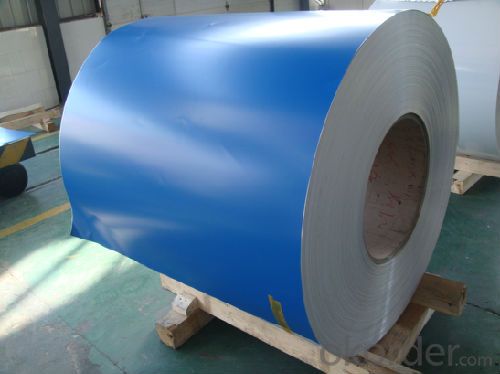
4. Product detailed sizes:
1000mm*2000mm, 1219mm*2438mm,1220mm*2440mm, 1250mm*2500mm,1500mm*3000mm, etc.
5. FAQ:
What is the quality standard?
---Usually our standard is GB3880-2006 or else.
What is the width range?
---It is from 1000mm to 2500mm, etc.
What is the length range?
---It is from 2000mm to 6000mm, etc.
What is the MOQ for your products yet?
---Normally it is around 3 tons/each size.
How many tons did you export in one year?
---Normally it is around 9000 tons totally.
Where is your client from?
---Normally it is from Japan, USA, ENGLISH, SINGAPORE, ETC.
What is your mainly products?
---Normally they are stainless steel sheet, stainless steel coil, stainless steel checkered sheet, stainless steel mirror finished sheet, color coated stainless steel sheet, etc.
- Q: Can stainless steel sheets be used for roofing?
- Yes, stainless steel sheets can be used for roofing. Stainless steel is highly durable, corrosion-resistant, and can withstand extreme weather conditions, making it a suitable material for roofing applications.
- Q: Which is better, stainless steel plate kitchen?
- According to the organizational structure of classification at room temperature, a martensitic, Austenitic, Ferritic and duplex stainless steel; according to the classification of the main chemical components, basically can be divided into chromium and chromium nickel stainless steel two systems; by use of minute nitric acid resistant stainless steel, stainless steel, stainless steel corrosion resistance to sulfuric acid and so on, according to the corrosion resistance the type can be divided into stainless steel pitting corrosion, stress corrosion resistant stainless steel, intergranular corrosion resistant stainless steel etc.;
- Q: How do I clean and maintain stainless steel sheets?
- To clean and maintain stainless steel sheets, start by wiping them down with a mild soap and water solution or a non-abrasive cleaner. Rinse thoroughly and dry with a clean cloth to prevent water spots. Avoid using harsh chemicals, abrasive sponges, or steel wool as they can damage the surface. For tougher stains or fingerprints, you can use a vinegar and water solution or specialized stainless steel cleaners. Finally, regularly polish the sheets with a stainless steel cleaner or olive oil to restore their shine and protect against future stains.
- Q: Can stainless steel sheets be used for elevator shafts?
- Elevator shafts can indeed utilize stainless steel sheets, as they offer durability, resistance to corrosion, and an appealing aesthetic. By employing stainless steel sheets, one can ensure a lasting and easy-to-maintain solution, as they resist rust and corrosion caused by factors like humidity, moisture, and chemicals. Moreover, stainless steel possesses strength and can withstand the weight and stress typically encountered by elevator shafts. The sleek and contemporary look of stainless steel further enhances the overall design value of the elevator shaft. Consequently, stainless steel sheets serve as a dependable and fitting material choice for constructing elevator shafts.
- Q: How are stainless steel sheets made?
- Stainless steel sheets are made through a process known as hot rolling. The production starts with melting various quantities of iron, nickel, chromium, and other elements in an electric arc furnace. This mixture is then cast into large rectangular blocks known as slabs. The slabs are heated to extremely high temperatures and then passed through a series of hot rolling mills. These mills consist of a set of large rollers that gradually reduce the thickness of the slab while increasing its length and width. As the slab passes through each rolling mill, it is continually squeezed between the rollers, resulting in a thinner and longer sheet. After the hot rolling process, the stainless steel sheet is annealed. Annealing involves heating the sheet to a specific temperature and then allowing it to cool slowly. This process helps to relieve internal stresses and improve the material's mechanical properties. The next step is pickling, where the sheet is immersed in an acid solution to remove any surface impurities and oxides. This enhances the appearance and corrosion resistance of the stainless steel. Once the pickling process is complete, the sheet is cold rolled. Cold rolling further reduces the thickness of the sheet and improves its surface finish. Cold rolling is performed at room temperature, which increases the hardness and strength of the stainless steel. Finally, the stainless steel sheet undergoes various finishing processes. These can include cutting to size, leveling, surface polishing, and coating to enhance its appearance or protect it from corrosion. Overall, the manufacturing process of stainless steel sheets involves a combination of melting, casting, hot rolling, annealing, pickling, cold rolling, and finishing processes. This ensures that the final product meets the desired specifications, including thickness, strength, and surface finish.
- Q: Are stainless steel sheets suitable for railway applications?
- Yes, stainless steel sheets are suitable for railway applications. They offer excellent corrosion resistance, durability, and strength, making them ideal for various components such as train carriages, structural elements, and infrastructure. Additionally, stainless steel's low maintenance requirements and ability to withstand harsh environmental conditions make it a reliable choice for railway applications.
- Q: Can stainless steel sheets be used for pharmaceutical storage cabinets?
- Yes, stainless steel sheets can be used for pharmaceutical storage cabinets. Stainless steel is highly resistant to corrosion, making it an ideal material for storing pharmaceuticals, which often require sterile and hygienic conditions. Stainless steel is also easy to clean and maintain, ensuring that the storage cabinets remain contamination-free. Additionally, stainless steel is durable and long-lasting, providing a reliable and secure storage solution for pharmaceuticals.
- Q: What are the common grades of stainless steel sheets used in construction?
- The common grades of stainless steel sheets used in construction are typically classified as austenitic, ferritic, or duplex stainless steels. Austenitic stainless steels, such as 304 and 316, are the most widely used grades due to their excellent corrosion resistance and high strength. These grades are commonly used in architectural applications, roofing, cladding, and structural components. Ferritic stainless steels, like 430, are known for their good corrosion resistance and high toughness, making them suitable for applications where strength and durability are important. They are often used in decorative applications, interior design elements, and automotive trim. Duplex stainless steels, such as 2205, offer a combination of excellent corrosion resistance and high strength, making them ideal for heavy-duty applications in construction. These grades are commonly used in bridges, offshore structures, and industrial plants where superior strength and resistance to chloride-induced stress corrosion cracking are required. It's important to note that the selection of the grade of stainless steel sheet depends on the specific requirements of the construction project, such as the environment, load-bearing capacity, and aesthetic considerations. Consulting with a materials engineer or a stainless steel supplier can help determine the most suitable grade for a particular construction application.
- Q: What is the maximum thickness of stainless steel sheets for bending?
- The maximum thickness of stainless steel sheets for bending depends on several factors such as the type of stainless steel, the bending method used, and the equipment available. In general, stainless steel sheets up to 3/16 inch (4.76mm) thick can be readily bent using common bending techniques and equipment. However, thicker sheets may require specialized machinery or processes such as hydraulic or press braking to achieve the desired bend. It is important to consult with a metal fabrication expert or refer to specific bending guidelines provided by the stainless steel manufacturer to determine the maximum thickness that can be effectively bent for a particular application.
- Q: What is the area of stainless steel plate?
- For example, a steel coil with known weight, thickness, length, width, and price, you can work out the cost price of each meter, and then you can set the price as you expect it
Send your message to us
Stainless Steel Cold Rolled Sheet Stocks In Warehouse
- Loading Port:
- Shanghai
- Payment Terms:
- TT or LC
- Min Order Qty:
- 5 m.t.
- Supply Capability:
- 5000 m.t./month
OKorder Service Pledge
OKorder Financial Service
Similar products
Hot products
Hot Searches
Related keywords

